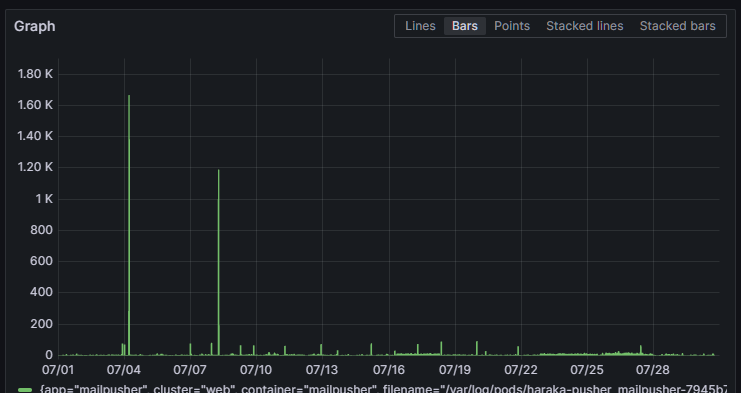given time in lieu
after squadron 42 ships*
given time in lieu
after squadron 42 ships*
TIL, thanks!
I had exactly the same use case and I ended up with a 40G DAC fiber for that case. It ended up cheaper than converting the whole lan to 10G.
That said, it feels like used 10G equipment is easier to come by than 2.5G for now, and if you have 2G fiber uplink and only 1G past the router then it’s a waste.
Garage is trivial to get up and running and it’s more lightweight than minio nowadays.
No. It's my in-cluster storage that I only use for things that are easier to work with via S3 api, and I do backups outside of the k8s scope (it's a bunch of various solutions that boil down to offsite zfs replication, basically). I'd suggest you to take a look at garage's replication features if you want it to be durable.
Actual public services run there, yeah. In case if any is compromised they can only access limited internal resources, and they'd have to fully compromise the cluster to get the secrets to access those in the first place.
I really like garage. I remember when minio was straightforward and easy to work with. Garage is that thing now. I use it because it's just co much easier to handle file serving where you have s3-compatible uploads even when you don’t do any real clustering.
Between homebrew and nix, the amount of foss macs can run out of the box is pretty close to some generic Ubuntu (nixpkgs is technically the largest repo out there, but not all of the nixpkgs are available on mac).
I’ve dealt with exactly the same dilemma in my homelab. I used to have 3 clusters, because you'd always want to have an "infra" cluster which others can talk to (for monitoring, logs, docker registry, etc. workloads). In the end, I decided it's not worth it.
I separated on the public/private boundary and moved everything publicly facing to a separate cluster. It can only talk to my primary cluster via specific endpoints (via tailscale ingress), and I no longer do a multi-cluster mesh (I used to have istio for that, then cilium). This way, the public cluster doesn’t have to be too large capacity-wise, e.g. all the S3 api needs are served by garage from the private cluster, but the public cluster will reverse-proxy into it for specific needs.
any oauth (I use kanidm) and oauth2-proxy solves that and now you can easily use passkeys to log into your intranet resources.
The biggest certainty is that just having an open port for an SMTP server dangling out there means you will 100% be attacked.
True.
Not just sometimes, non-stop.
True
So you don't want to host on a machine with anything else on it, cuz security.
I don’t think "cuz security" is a proper argument or no one would be ever listening on public internet. Are there risks? Yes.
So you need a dedicated host for that portion
Bullshit. You do not need a dedicated host for smtp ingress. It won’t be attacked that much.
and a very capable and restrictive intrusion detection system (let's say crowdsec), which is going to take some amount of resources to run, and stop your machine from toppling over.
That's not part of the mail pipeline the OP asked for.
Here, I brought receipts. There are two spikes of attempted connections in the last month, but it's all negligible traffic.

Self-hosting mail servers is tricky, same as self-hosting ssh, http, or whatever else. But it's totally doable even on an aging RPi. No, you don’t need to train expensive spam detection because it's enough to have very strict rules on where you get mail from and drop 99% of the traffic because it will be compliant. No, you don’t need to run crowdstrike for a server that accepts bytes and stores them for another server (IMAP) to offer them to you. You don’t even need an antivirus, it's not part of mail hosting, really.
Instead of bickering and posturing, you could have spent your time better educating OP on the best practices, e.g. like this.
I won’t quote the bit of your post again, but no, if you have an open smtp port then you won’t get constantly attacked. Again, I have a fully qualified smtp server and it receives about 40 connections per hour (mostly the spam ones). That's trivial to process.
It doesn’t matter that I forward emails from another server, because, in the end, mine is still public on the internet.
If you are trying to make a point that it's tricky to run a corporate-scale smtp and make sure that end users are protected, then it's clearly not what the OP was looking for.
ECC is slightly more required for ZFS because its ARC is generally more aggressive than the usual linux caching subsystem. That said, it's not a hard requirement. My curent NAS was converted from my old windows box (which apparently worked for years with bad ram). Zfs uncovered the problem in the first 2 days by reporting the (recoverable) data corruption in the pool. When I fixed the ram issue and hash-checked against the old backup all the data was good. So, effectively, ZFS uncovered memory corruption and remained resilient against it.